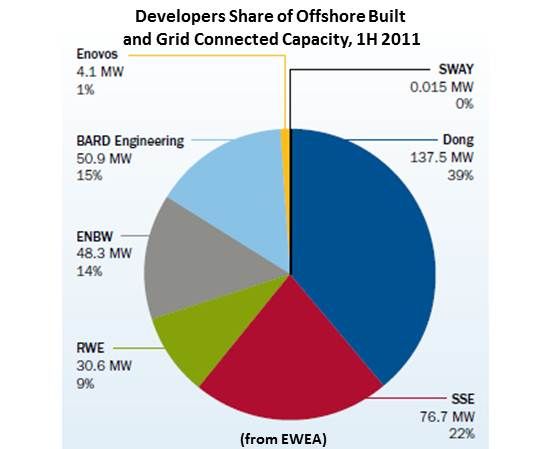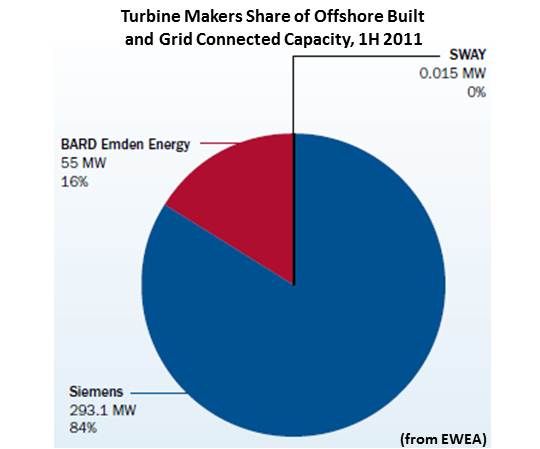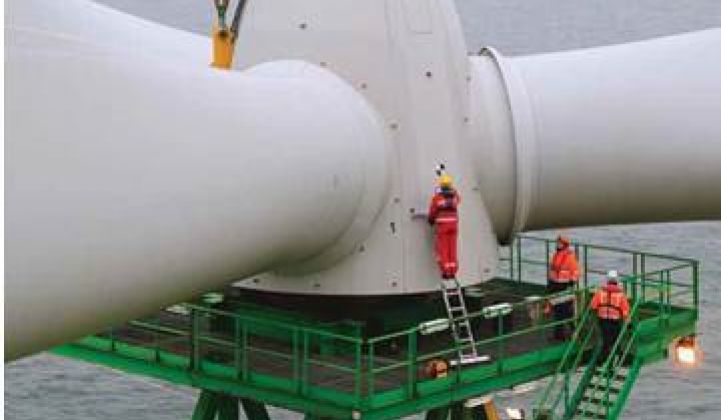The new ocean transmission system is another major step forward in development of the offshore wind power the Merkel government will need realize its ambitious, recently announced plan to abandon all nuclear power generation by 2022. Germany intends to double its present 27 gigawatts of wind capacity -- eight percent of its electricity requirements -- by 2020. Much of the new capacity will have to be offshore because so many of the available land sites have been used.
Skeptics say Germany can’t build enough offshore wind and other renewables to free them from nuclear power, and many have opined that the decision to abandon nuclear will result in more coal consumption, the purchase of French nuclear-generated electricity and higher German electricity bills. However, these skeptics may be underestimating the viability of Europe’s offshore wind industry.
In 2010, 2.6 billion euros were invested in offshore wind, according to the European Wind Energy Association (EWEA). The list of banks willing and approved to provide capital for European offshore projects now numbers over 20 and is growing rapidly, EWEA reported. Banks are expected to serve up a record three billion euros for offshore wind farms in 2011.
EWEA estimates investment in offshore wind will be 10.4 billion euros in 2020 and 17.1 billion euros in 2030.

The recently announced KfW Bankengruppe program alone will provide five billion euros to 10 German projects. Support from Denmark’s EKF export credit agency and the European Investment Bank (EIB) is expected to continue, and the recently started U.K. Green Investment Bank is expected to be active in the sector soon.
Europe built 4.5% more offshore wind in 1H2011 than in 1H2010. The U.K., Germany and Norway built and connected 101 new turbines offshore with a capacity of 348 megawatts.
This brought Europe’s installed offshore capacity to 3,294 megawatts (49 wind farms in nine countries with 1,247 grid-connected turbines).
Eleven more offshore wind farms, representing a 2,844-megawatt capacity and a total value of 8.5 billion euros, are under construction.
EWEA estimates Europe will have 40 gigawatts of installed offshore wind capacity in 2020 and 150 gigawatts in 2030.

The 400-megawatt Gode Wind II wind farm is the third German offshore project that ABB has been tapped to connect to the grid. The company will design, engineer, supply and install a 900-megawatt-carrying-capacity HVDC land and sea cable system, the offshore platform, and the offshore and onshore converter stations.
The highly efficient 320-kilovoltHVDC lines, which limit electrical losses to less than 1 percent per converter station, will take the power generated at Gode Wind II and other wind farms to an offshore HVDC converter station. From there, the electricity will be transferred via 135 kilometers of underwater and underground cables to an onshore HVDC station at Dörpen on the German coast, and from there will travel to the mainland grid.
The ABB transmission system is the kind of advanced technology and advanced capability the European offshore industry is ready to build, and it suggests that the Merkel government was not acting out some irrational green ideal when it shifted its commitment and priorities away from nuclear power.
Merkel, a physicist before she became a politician, can understand better than most world leaders the implications of such a technological capability. Her insight into offshore wind’s potential is no doubt buoyed by results from Research at Alpha Ventus (RAVE), a remarkably comprehensive public-private research program initiated in 2006 and built into the North Sea construction of the 60-megawatt Alpha Ventus wind farm, the world’s first deep water offshore wind project.
Interestingly, the other world leadership that is shifting its priorities to offshore wind is that of China. Eight of the nine members of its politburo began their careers as engineers.
The Chinese government recently announced that its preferential supports to wind turbine manufacturers will not be extended to those without the capability to turn out turbines at an offshore-wind-sized (2.5 megawatts or greater) scale.



